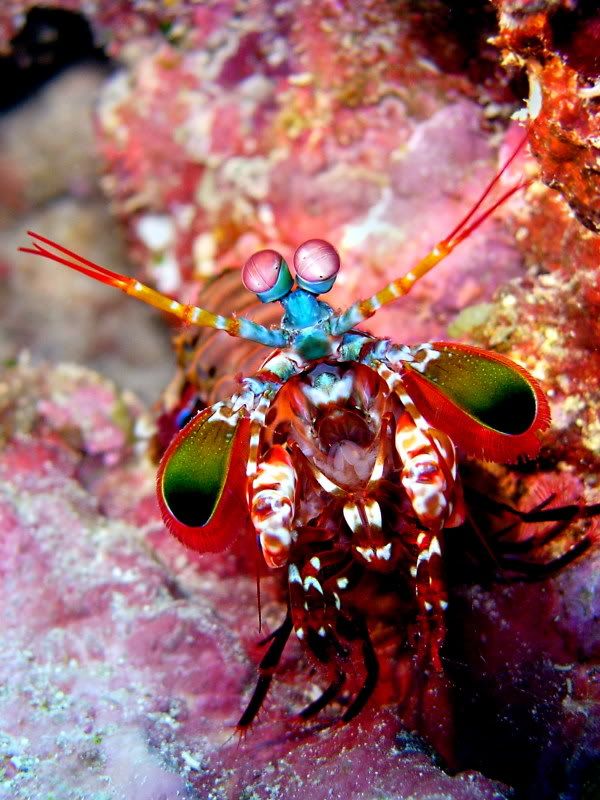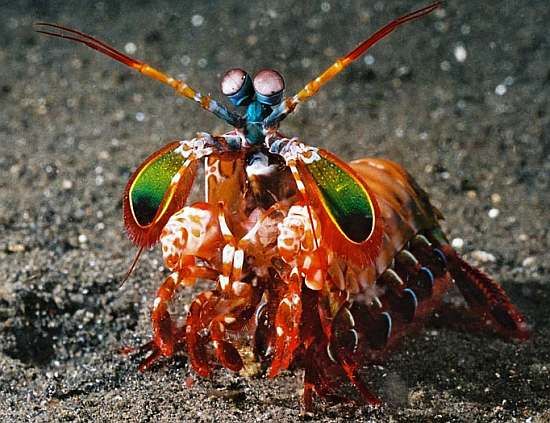Here Sunsational04 these are cute.
I present The Mantis Shrimp
Funny thing is it is neither shrimp nor mantid. They are also occasionally refered to as "Thumb Splitters" by divers because their Spear-like claws can not only break a finger but in many cases have fully mutilated fingers in a single strike/punch. The "punch" is delivered with blinding quickness, with an acceleration of 10,400 g and speeds of 23 m/s from a standing start, or about the acceleration of a .22 caliber bullet. Because they strike so rapidly, they generate cavitation bubbles between the appendage and the striking surface. The collapse of these cavitation bubbles produces measurable forces on their prey in addition to the instantaneous forces of 1,500 N that are caused by the impact of the appendage against the striking surface, which means that the prey is hit twice by a single strike; first by the claw and then by the collapsing cavitation bubbles that immediately follow. Even if the initial strike misses the prey, the resulting shock wave can be enough to kill or stun the prey.
The snap can also produce sonoluminescence from the collapsing bubble. This will produce a very small amount of light and high temperatures in the range of several thousand kelvin within the collapsing bubble, although both the light and high temperatures are too weak and short-lived to be detected without advanced scientific equipment. The light emission and temperature increase probably have no biological significance but are rather side-effects of the rapid snapping motion. Pistol shrimp produce this effect in a very similar manner.
Smashers use this ability to attack snails, crabs, molluscs and rock oysters; their blunt clubs enabling them to crack the shells of their prey into pieces. Spearers, on the other hand, prefer the meat of softer animals, like fish, which their barbed claws can more easily slice and snag.Although generally considered an urban legend due to few occurrences, some larger species of mantis shrimp are capable of breaking through aquarium glass with a single strike from this weapon.
Mantis shrimp possess hyperspectral colour vision, allowing up to 12 colour channels extending in the ultraviolet. Their eyes (both mounted on mobile stalks and constantly moving about independently of each other) are similarly variably coloured, and are considered to be the most complex eyes in the animal kingdom. They permit both serial and parallel analysis of visual stimuli.
Each compound eye is made up of up to 10,000 separate ommatidia of the apposition type. Each eye consists of two flattened hemispheres separated by six parallel rows of highly specialised ommatidia, collectively called the midband, which divides the eye into three regions. This is a design which makes it possible for mantis shrimp to see objects with three different parts of the same eye. In other words, each individual eye possesses trinocular vision and depth perception. The upper and lower hemispheres are used primarily for recognition of forms and motion, not colour vision, like the eyes of many other crustaceans.
Rows 1-4 of the midband are specialised for colour vision, from ultra-violet to infra-red. The optical elements in these rows have eight different classes of visual pigments and the rhabdom is divided into three different pigmented layers (tiers), each adapted for different wavelengths. The three tiers in rows 2 and 3 are separated by colour filters (intrarhabdomal filters) that can be divided into four distinct classes, two classes in each row. It is organised like a sandwich; a tier, a colour filter of one class, a tier again, a colour filter of another class, and then a last tier. Rows 5-6 are segregated into different tiers too, but have only one class of visual pigment (a ninth class) and are specialised for polarisation vision. They can detect different planes of polarised light. A tenth class of visual pigment is found in the dorsal and ventral hemispheres of the eye.
Mantis shrimp - Wikipedia, the free encyclopedia


